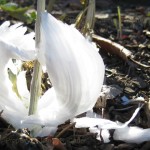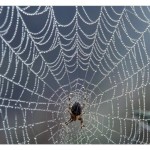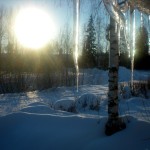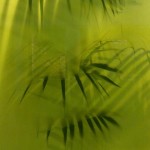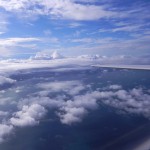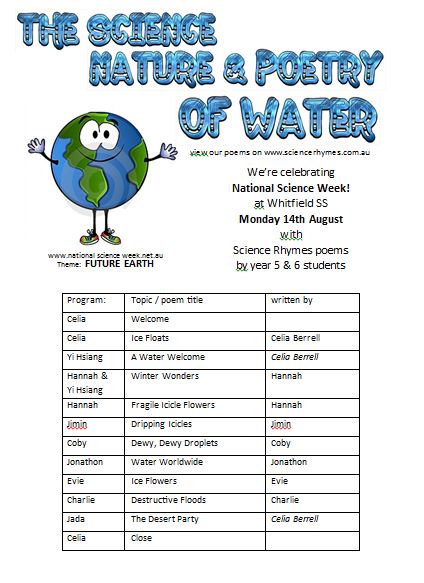Celebrating World Space Week (October 4-10):
A Journey in Space by Frances
(Trinity Anglican School – White Rock)
I have a dream to go to space
because space is an amazing place.
In space, stars shine like little lights.
I’d love to touch their mighty heights.
Ten, nine, eight, seven, six, five, four …
We’re going to leave this Earthly floor.
Three-two-one, we’re blasting off.
We’re going to space! It could be tough.
Flying through Earth’s thin atmosphere
we’re finally in space – we’re finally here!
Looking back, what do I see?
Mercury, Venus and Sun face me.
Moving on to miraculous Mars,
zoom and see a heap of stars.
Flying into the Asteroid Belt …
mind those little rocks don’t pelt.
Flying through the asteroids
each one’s a challenge to avoid.
I see the king of the Milky Way
where Jupiter’s colours swirl and sway.
Saturn’s beautiful rings of ice
can freeze us all in just a trice.
Next we fly past Uranus
then Neptune, blue and serious.
And now it’s time to go back home
as I need to search on Google Chrome.
I must find out about all space.
Yes space, the most amazing place.
Our Solar System by Annabelle
(Trinity Anglican School – White Rock)
There I travel, it’s awfully dark.
Then I see a great gleaming spark.
Our Sun’s a bright star, I should say
as I continue to lead the way.
Mercury’s circling close to the Sun.
I wouldn’t believe it could be much fun.
What traps heat, has thick clouds and hot base?
Venus! The second planet in space.
Earth has nature, life and seas
and hasn’t gone past fifty-eight degrees.
Maybe there’s water, maybe there’s not.
Mars is mostly red dust and rock.
With swirls and twirls, what’s far from small?
Jupiter, Yes! It’s the biggest of all.
That great red spot, a perpetual storm.
If you go in there, you will get torn.
Swirling gases and liquid patterns
make their home on gas giant Saturn.
Bits of ice scattered in Saturn’s rings.
Too cold for a penguin, even with wings.
Uranus ice giant, seventh from the Sun.
It also has rings: seventeen not one.
Neptune is such a beautiful blue
like a splendid sea and a cosmic zoo.
My journey has sadly come to an end.
But now I get to see my friend.
There is one space feature I did not list.
A super-special, sparkling bliss.
Our star is extremely hot indeed
turning and burning at very high speed.
One last glimpse into great bit space.
Oh what a beautiful marvellous place!
Overpowering Space by Paloma
(Trinity Anglican School – White Rock)
Planets floating in space
Responding to gravity’s reach
The Sun controlling every movement
Freedom is no longer available in space.
Do we all dance to the Sun’s command?
Mars, Saturn, Jupiter
Pluto, Neptune, Venus
Mercury, Earth, Uranus
Moons pulled by their planets
Some forced to follow their ruler
Scattered with hollows and craters
Unique landscapes with every turn
Rings, mountains, gas
Volcanoes, canyons, ice caps
Soil, desert, seas and lakes
Satellites uncovering secrets
Asteroids making their mark
Before their time comes to an end
This is what we call the overpowering space.
Moody Venus by Seby
Trinity Anglican School – White Rock
The second planet from the Sun
spins so slowly, never done
covered in clouds of white and brown
like Goddess Venus wearing a gown.
Underneath her fluffy clouds
she’s hiding many muddy mounds.
Rain-clouds drop burning sulphuric acid.
Venus is never peacefully placid!
A Date with the Sun by Shamna
(Trinity Anglican School – White Rock)
Space has so many glistening stars.
From Earth, they are extremely far.
Our Sun is one of these fiery spheres
with fuel to last five billion years.
Then our Sun will explode one day …
probably on the second of May.
Adventures in Space by Andrew
(Trinity Anglican School – White Rock)
Space is an awesome place.
I couldn’t say it’s a place I’d embrace.
The hottest sphere is the starry Sun
and I know our System only has one.
The closest planet to Earth is Mars
shining red against the stars.
With further to travel, Mars appears
to orbit our Sun in two Earth years …
while sunbeams shoot like giant swords.
Can they stop us from getting bored?
Wonders of Space by Georgia
(Trinity Anglican School – White Rock)
The mountains of Pluto are cold.
To climb them, you’d need to be bold.
Poor Pluto’s too small
and not very tall
rejected as planet we’re told.
The Sun is extremely hot.
It orbits our planet – NOT!
Let’s fly to the Sun
it will be lots of fun
and remember the course we’re to plot.
Uranus rolls on a tilt.
So cold, it would make the plants wilt.
Such icy-cold air
in its thick gassy layer
you’ll need a ten thousand mile kilt.
Saturn has more than one ring.
Perhaps it has more than one king!
Saturn’s quite big
made of gas you can’t dig
but kings will love beautiful bling.
Jupiter has swirling storms
though its surface is not very warm.
How to inform us
this planet’s enormous?
You’ll have to wait ten hours ’til dawn.
Venus glows bright in the night
and still shines in dawn’s early light.
She looks like a star
as from Earth, it’s not far.
Our neighbour’s a sparkling sight.
Earth is third from the superb Sun.
Our home – it’s fantastically fun.
With hot and cold water
for summer and winter.
And now my space poem is done!
Dark-Dark Space by Sean
(Trinity Anglican School – White Rock)
The Sun is so hot
like a big round pot.
It’s a fiery ball
getting ready to fall.
It’s incredibly bright
giving Earth lots of light.
While dark-dark space
is the blackest place
it’s scattered with stars
and planets like Mars.
Our Sun has eight planets
and four contain granite.
Mercury: closest one
orbiting round our Sun.
One side’s too hot
while the other is not.
We know it is there
but it hides in Sun’s glare.
Venus: a guiding light
close to Earth, seems so bright.
Planet of pock-marked rock
pounded by meteor knocks.
Clouds hide her bumpy ground
while Venus spins around.
Earth is a place with life
where man can have a wife.
Thirty percent is land
five percent’s made of sand.
Earth’s liquid water
helps make it less hotter.
Mars is a rusty red
just like my old bed-spread.
Famed for its volcano
largest of all we know.
Plus, there’s two tiny moons
Man hopes to visit soon!
Our Terrestrial Planets by Daniel
(Trinity Anglican School – White Rock)
Planet Mercury: the closest one
to our luminous life-giving Sun
can be so cold and really hot.
It’s the smallest planet of the lot.
Whose day is bigger than its year?
Whose atmosphere is never clear?
A neighbour, shining in the night.
Watch as Venus takes her flight.
The Earth is twenty-nine percent land
when from a satellite it’s scanned.
It’s the only one of which we know
where life and people live and grow.
Mars is the second smallest planet
of the terrestrials made of granite.
The outermost and furthest one
orbiting round our big red Sun.
Counting the Gassy Giant Planets by Brant
(Trinity Anglican School – White Rock)
Jupiter: fifth away from the Sun
the Solar System’s largest one.
Jupiter has three rings of dust
plus clouds of yellow, brown, white and rust.
Saturn is sixth away from our star
with thousands of icy rings stretching far.
Saturn has lots of hydrogen gas
but not much helium – alas.
Seventh: Uranus spins on its side
and has a rocky core inside.
Its atmosphere is quite extreme.
Landing a space craft would NOT be a dream!
Eighth, blue Neptune has six faint rings
made of gas and dust and things.
Its winds are nine-times stronger than Earth’s.
But what’s the point … if there is no surf?
Space Dots and Spots by Aiden
Trinity Anglican School – White Rock)
Jupiter has a gassy red spot
but from Earth it only looks like a dot.
The biggest planet to orbit the Sun,
if size was a contest, Jupiter’s won!
Neptune’s moons are extremely cold.
Thirteen are tiny; bit Triton is bold.
Neptune’s winds are chilly and high.
They’d blow your skin off and then you’d die.
The Sun is so dazzlingly bright and hot.
After you looked, you’d see only dots!
The Sun is our giant, life-giving ball.
One day it will die and all life will fall.
Down here on Earth, if you look to the sky,
you might see two pretty doves flying by.
But if you were floating around in space
you might see two meteors having a race.
Circling Our Solar System by Xavier
(Trinity Anglican School – White Rock)
Lost in space, looking for Mars
I’m dizzy from seeing millions of stars!
Dwarf planet Pluto’s orbit runs far
as it takes it away from our central star.
Makemake in the Kuiper Belt
is hanging around where Pluto dwelt.
Neptune was named as the god of the sea.
We’ll find other god names in planets we see.
His brother Uranus orbits close by.
This planet was named as the god of the sky.
Saturn’s ice rings are shining bright.
Its sixty-two moons dance to the right.
Jupiter harbours a big red dot
which we’ve no idea how it got!
Ceres is found in the Asteroid Belt
being bumped around at quite a pelt.
Venus is called our evening star.
The steamiest hottest planet by far.
The green and blue planet Earth is our home
where millions of creatures are free to roam.
Mercury circles close to the Sun
which means it has not water that runs.
This brings us down to the final one.
The hear of our Solar System – the Sun!
SHE is the reason why we are here.
Let’s hope our Sun doesn’t disappear.
The Dwarf Planet Pluto by Tilleah
(Trinity Anglican School – White Rock)
I think that’s planet Pluto!
Pluto’s very small, so …
does it orbit round our Sun
or does it orbit another one?
I wonder if we’ll ever know
if we were wrong about Pluto.
There’s lots of dwarfs, just like you.
Smaller planets just like you
whose orbits go so very slow
far away from Sun’s warm glow.
Spacey Science by Emily
(Trinity Anglican School – White Rock)
Let’s go to see some gassy giants
and learn a little spacey science.
Jupiter has a cool red dot.
A pretty stormy Earth-sized spot.
Saturn has some icy rings
like harp-strings singing to a king.
Blue Neptune doesn’t have a tune
but cares for fourteen tiny moons.
The Solar System by Giaan
(Trinity Anglican School – White Rock)
Let’s travel through our Solar System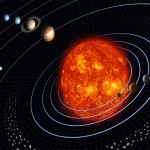
taking off like a powerful piston.
First let’s travel to the Sun
a star with lots of helium.
The Sun sparks up so burning bright
it’s like a giant electric light.
Next let’s pass the rocky planets.
All of them contain some granite.
Earth is where we love to live.
It’s where we all can eat and give.
Mercury, Venus were first on our list
but I like Mars the last one best.
Let’s go to the planet that has a big ring.
That gassy wonder is truly king.
First we’ll fly past Jupiter
and hope we don’t get stupider.
Jupiter, Saturn, Uranus and Neptune
are all like gassy balloon cartoons.
Now let’s talk of the Milky Way.
That sweep of stars like a curved highway
with asteroids, comets all zooming above.
But the Milky Way is the one I love.
And here we are, one in a million
or maybe even a billion trillion.
Singing Rings by Ella
(Trinity Anglican School – White Rock)
Our Solar System everyone loves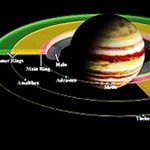
with its planets and asteroids circling above.
Mars is known as the rusty red planet
and just like Earth, it is full of granite.
Wonderful Jupiter has faint rings
but sadly those rings don’t seem to sing.
The Sun is our star and brightest of all.
At the end of the day, did you see it fall?
Galaxy Wisdom by Abbey
(Trinity Anglican School – White Rock)
There are many Solar Systems around
some are big, others small and round.
The Milky Way is our galaxy space
where planets never stay in one place.
Our shiny Sun might be amusing
but its solar flares are very confusing.
Beyond our bright blue atmosphere
they can damage satellites every year.
The outer gas planets are really massive
and bloated by their mix of gases.
Earth is small but far more dense.
Our rocky planets make much more sense.
Dwarf planets might be super-small
(just like my friend who’s not very tall).
There’s five dwarf planets in our system
but they’ll soon find more – if you want my wisdom!
Saga of a Solar System Space-probe by William
(Trinity Anglican School – White Rock)
Blasting off from our homeland Earth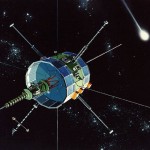
Out to look for some brand new turf.
Passing by the red planet Mars
Out towards the unexplored stars.
Past Phobos and Deimos two irregular moons
The most dangerous stage of my voyage is soon.
NASA is happy the trip is a success
Should we travel on further? The director says “Yes”.
Jupiter’s next, with its swirling storm
The marbled surface is far from warm
Bobbing and weaving and learning their pattern
Out of the Asteroid Belt towards Saturn.
Sampling the gas giant’s rings of dust
Using its gravity, gaining more thrust.
Then off-tilt Uranus, with crystals of ice
Mission Control says “those pictures are nice”.
Most planets are named after gods of Rome.
My journey has taken me far from home.
My mission is over. I’ve run out of fuel.
Now all this knowledge you’ll learn in school.
Finally, Neptune. The end of the line.
Since I blasted off, I’ve had a wondrous time!
Down through the atmosphere Crash! Bang! Boom!
Plummeting down to my freezing cold doom.



























